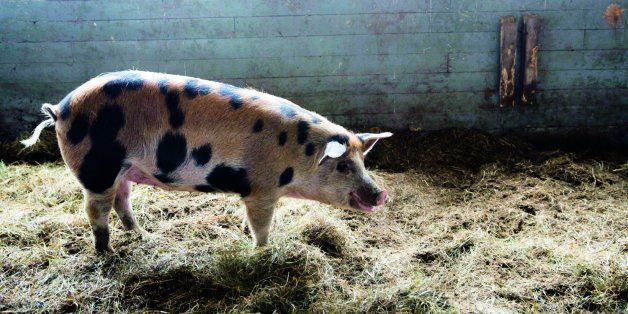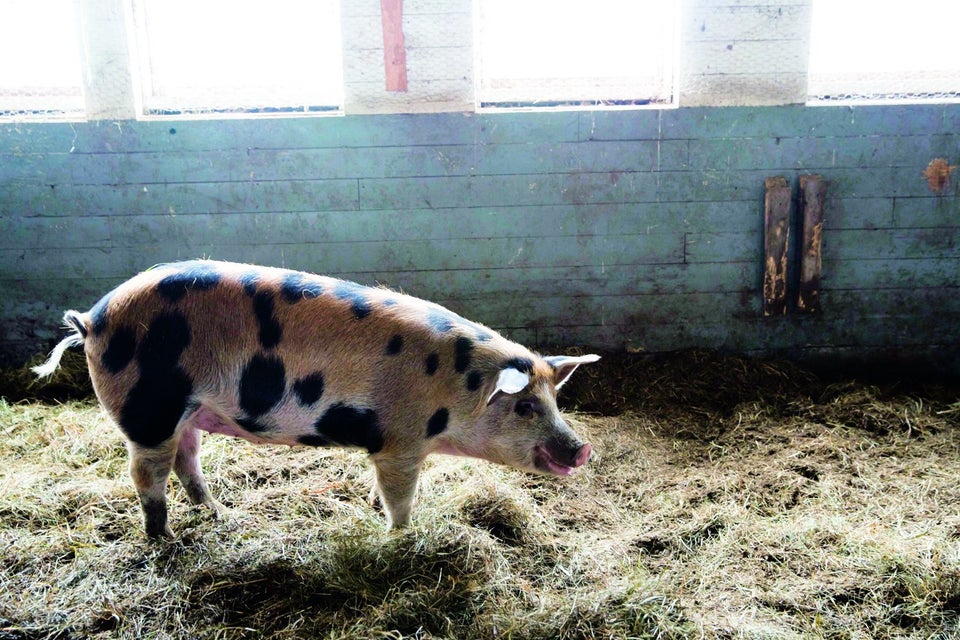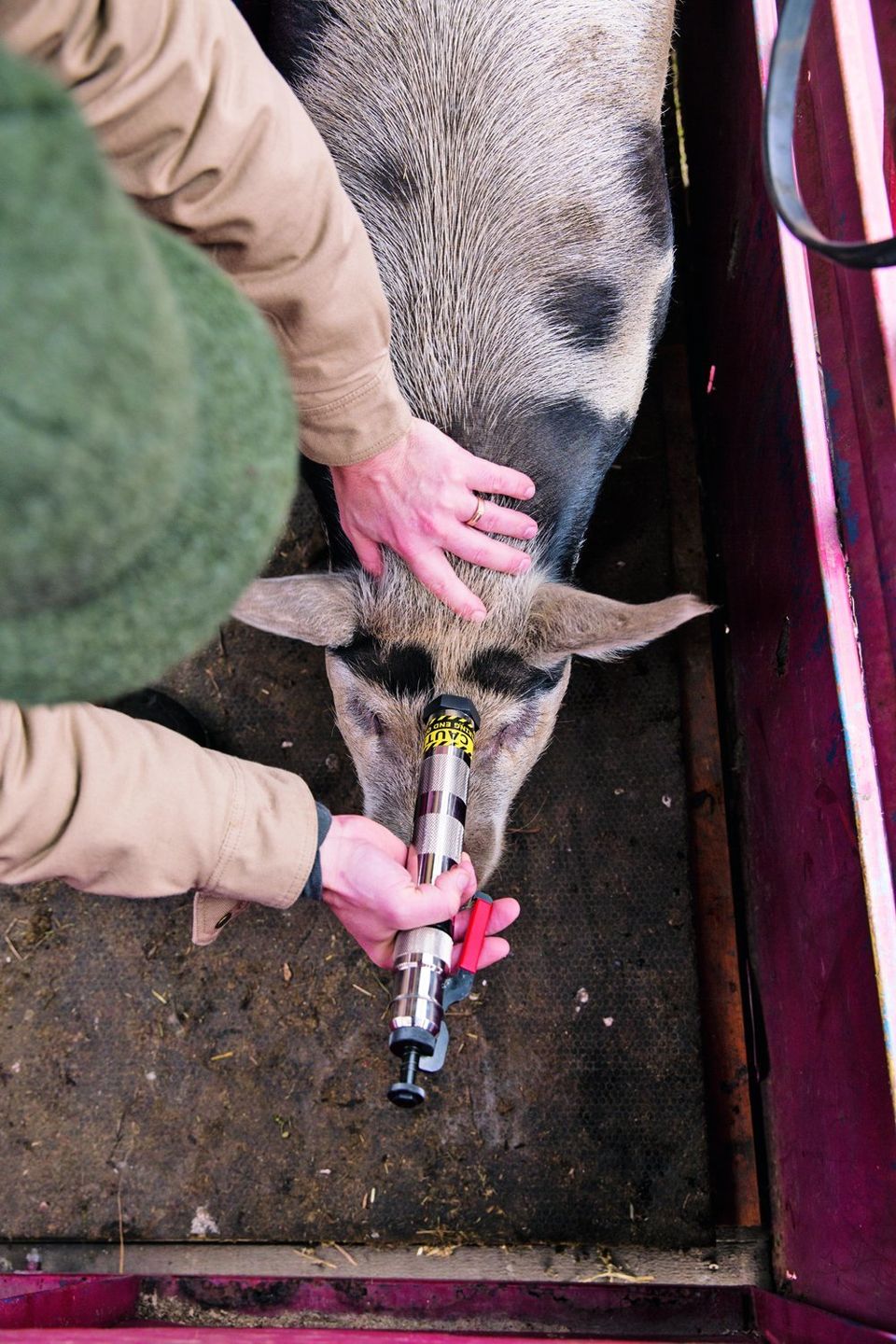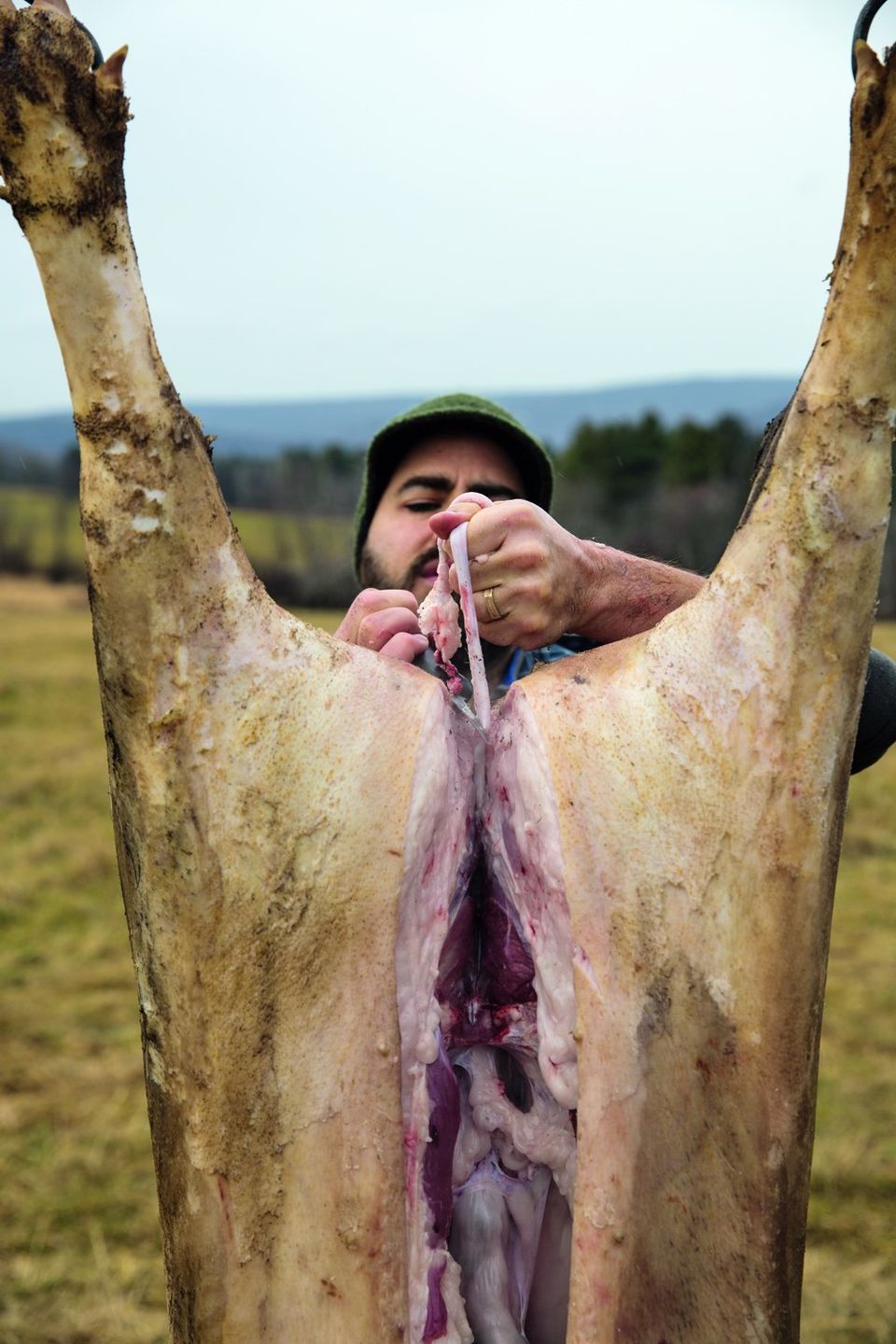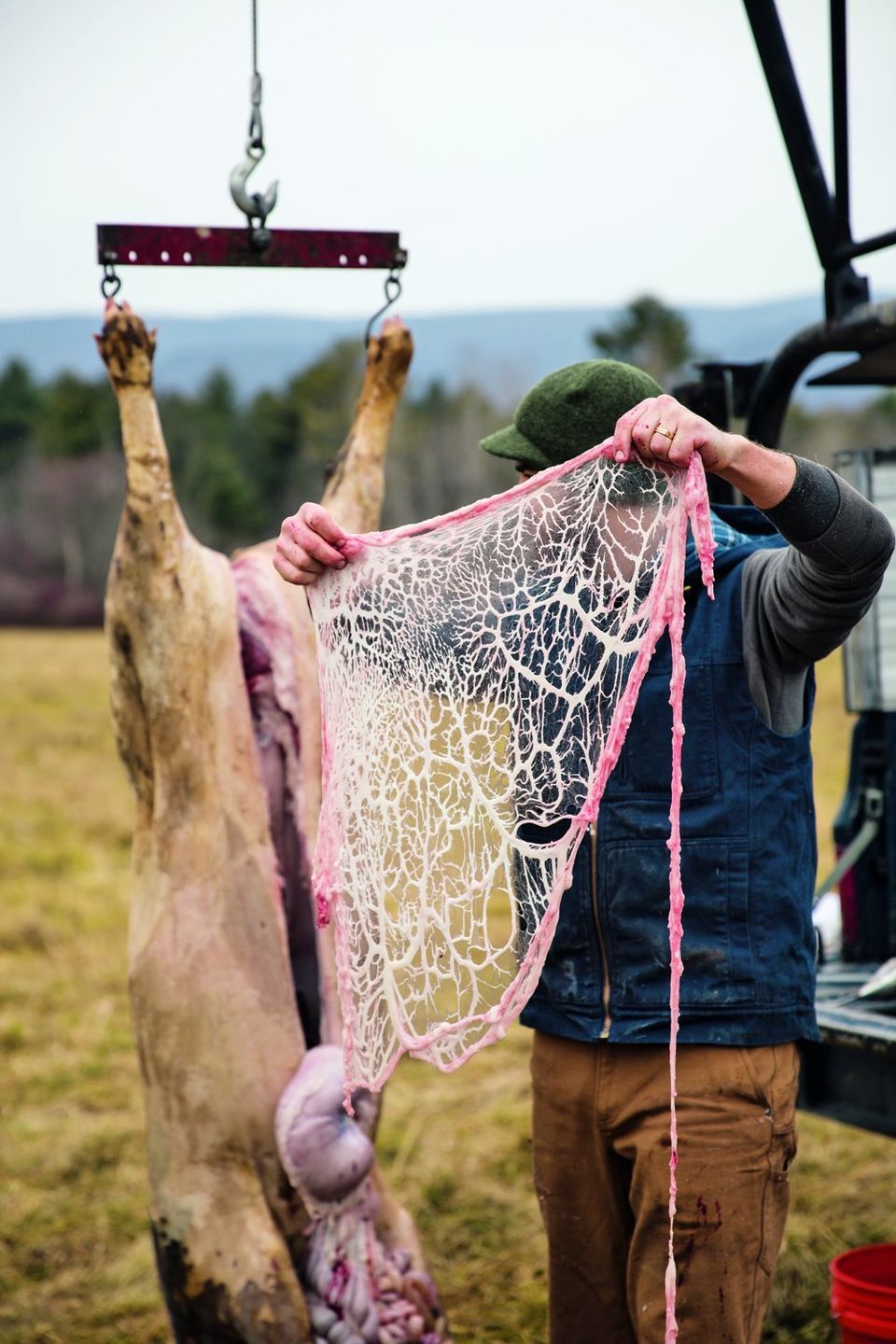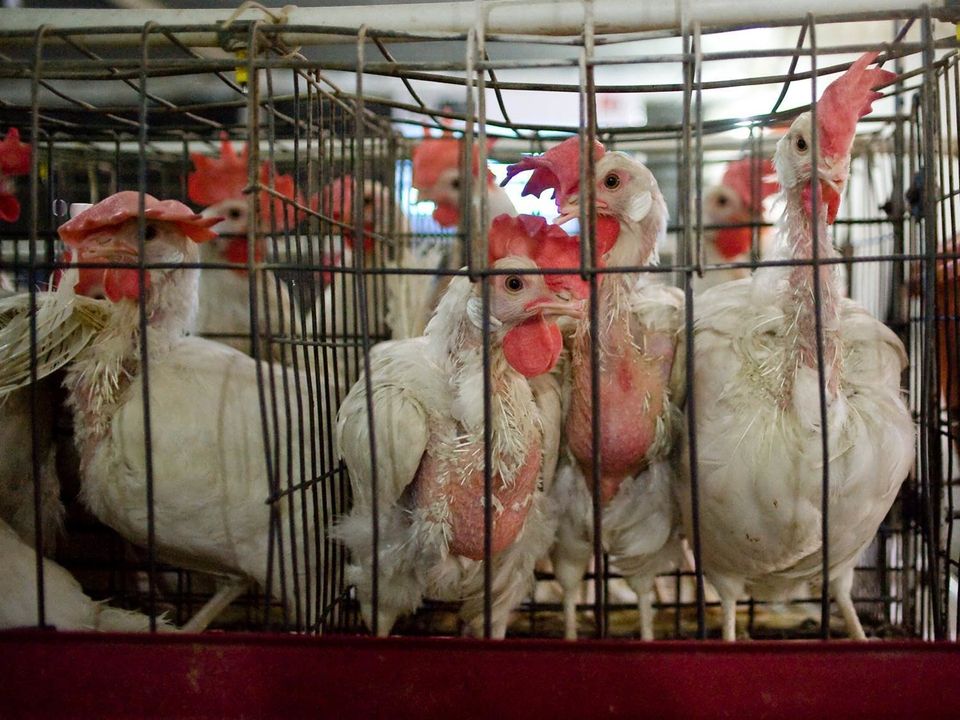Some of us shrink at the idea of even touching a piece of raw bacon, but have no qualms about eating it once it's crisped up and sizzling. Now imagine that your bacon didn't enter your kitchen prettily shrink-wrapped on a styrofoam tray, but rather that it walked into your kitchen in the form of a living, breathing pig. You'd have to slaughter it with your own two hands, shave it down, disembowel it and butcher it before cooking it up for dinner. It'd basically look like a scene from "Dexter," but it's a very real part of preparing food that many of us -- chefs and home cooks alike -- are able to avoid.
It's easy enough to imagine yourself being brave enough to slaughter a pig if you've never seen it go down, but we're about to show you what it really looks like. Let's see if you're still feeling so courageous after viewing the photos below.
We've been conditioned to envision pigs being mechanically slaughtered, hundreds at a time, on the conveyor belt of a factory farm. This conveniently creates a disassociation that frees us to eat our BLTs without feeling any guilt. But there's an entire industry of professionals who humanely raise and slaughter animals for a living, in an intensely personal and responsible way that's to be admired.
One of those professionals is Adam Danforth, the author of a new book series that sets out to educate those interested in humanely slaughtering their own food. It's called "Butchering: The Comprehensive Photographic Guide to Humane Slaughtering and Butchering" and there are two volumes: "Poultry, Rabbit, Lamb, Goat and Pork," and then an entire volume devoted to "Beef."
Danforth's book encourages backyard butchery and the movement away from the centralization of America's food system (think factory farms and mega supermarkets), self-empowering us to take matters into our own hands. The book and its detailed, step-by-step photos go deeply into every nuance of slaughtering an animal, from creating a stress-free environment while it's still alive, to preventing the spread of pathogens, collecting the proper tools for the job (i.e. bone saws) and making the most of every part of the animal.
Since pigs are the ultimate nose-to-tail, no-waste carcasses, we've decided to show you a few excerpts from the book that detail how to eviscerate a pig. Remember: You're only looking at the photos -- imagine if you came head-to-head with the task at hand. Vegetarians and the faint of heart, be wary: graphic images follow.
This Adorable Little Guy Is Going To Be Your Dinner
(c) Keller + Keller Photography
But First, You Have To Kill Him
(c) Keller + Keller Photography
The first step, and possibly the hardest to stomach for animal lovers, is to actually slaughter the animal. To summarize the process, it goes a little something like this: Stunning (seen in photo, which may remind you of a scene from "No Country For Old Men"), sticking a knife in the pig, bleeding it dry, hanging the pig from a hook, dropping it into a vat of scalding water, scraping the pig of its hair (just like shaving), and removing the toenails. (For detailed photos of this process,
check out the book. For our purposes, we're going to focus more on the next steps.) Now that that's done ...
EVISCERATING THE CARCASS -- Step 1: Sever The Skin
(c) Keller + Keller Photography
Walk to the front side and make an initial shallow cut from the rectum to the snout, just deep enough to sever the skin.
Step 2: Cut Around The Rectum
(c) Keller + Keller Photography
Stand behind the carcass and begin by cutting around the rectum, just deep enough to sever the skin and begin loosening its connections.
Step 3: Cut Along The Pizzle
(c) Keller + Keller Photography
(Ed. note: Pizzle = Penis. You can stop giggling now.)
When working with a male pig, make a shallow cut to one side of the pizzle. Follow that with another shallow cut on the opposite side of the pizzle, connecting it to the first cut just below the urogenital opening. Carefully cut along one side of the pizzle until you have identified the shaft that runs from the urogenital opening to the rectum.
#4: Separate The Pizzle
(c) Keller + Keller Photography
Continue to cut and separate the entire length on both sides, without severing the pizzle, and then toss is between the legs so that it hangs over the back. Be wary of leaking urine, an indication that the interior bladder is extremely full.
#5: Split The Abdomen
(c) Keller + Keller Photography
A few inches below the pelvis, make an incision about 6 inches long into the abdominal cavity. You cannot pinch the skin of pigs to help prevent accidental punctures of the bladder or other viscera; therefore, make safe, shallow cuts until you have broken through. Increase the initial incision using just the tip of your knife. Split the abdomen all the way to the sternum. If you are splitting the pubic symphysis, do so now, starting with cutting between the hams down to the pelvis.
#6: Tie The Bung
(c) Keller + Keller Photography
(Bung = Anus)
Pull up on the pizzle and finish separating it with the bung. Tie off the genitals and bung with string.
(Another View)
(c) Keller + Keller Photography
#7: Remove The Bung And Genitals
(c) Keller + Keller Photography
Pull the tied bung and genitals down and begin severing ureters and other connections, being careful not to puncture the bladder, until you can let them hang outside the cavity.
#8: Remove The Viscera
(c) Keller + Keller Photography
Reach in and pull up and out on the large mass of viscera, which includes the stomach, intestines, spleen, and liver.
#9: Retrieve The Caul Fat
(c) Keller + Keller Photography
Let the viscera partially hang out of the cavity and take a moment to remove, and save, the caul fat from around the stomach and intestines.
(Caul Fat)
(c) Keller + Keller Photography
The caul fat, which surrounds the viscera, should be saved for future use; it can be rendered or used for other culinary preparations.
#10: Remove The Liver And Spleen
(c) Keller + Keller Photography
(This pic is the spleen)
Remove the bile sac from the liver. Consider removing and saving the spleen, the long, purplish organ on the left side of the stomach. Hold the viscera mass with your non-knife hand, and begin to sever any remaining attachments, including the connection with the esophagus called the gastro-esophageal junction, while pulling the mass out of the cavity and depositing it into a waste container.
(Liver and Bile Sac)
(c) Keller + Keller Photography
#11: Split The Diaphragm And Separate The Sternum
(c) Keller + Keller Photography
Cut through the white connective tissue, following its curvature from one side to another. The muscle will retract once severed, exposing the thoracic cavity. Separate the sternum by running your knife slightly to either side of the very middle, moving through the cartilage of the ribs. If there is too much resistance, as with older animals, use a meat saw to split the sternum down the middle.
#12: Remove The Pluck
(c) Keller + Keller Photography
Grab the pluck (the heart and lungs) with one hand, and pull down and out through the bottom of the sternum, using your knife to cut blood vessels and other attachments. Remove the heart from the group; cut open the top, remove the clots, rinse, and save. Reach back inside and, with your knife, follow the remaining portion of the trachea and esophagus to the tongue and remove all three together. Inspect the interior for visceral remnants, glands, or other items that require removal.
#13: Remove The Kidneys
(c) Keller + Keller Photography
You may choose either to leave the kidneys for aging and carcass weight or to remove them for immediate cleaning and freezing. Pop the kidneys by scoring the surface membrane and squeezing them.
(The Kidneys)
(c) Keller + Keller Photography
And THEN the butchering part begins, which is a whole different story.
Now we've got one question for you: If you had to do all this to get meat on the table, would you still eat it? Why or why not? Let us know in the comments below.
The above is excerpted from Butchering Poultry, Rabbit, Lamb, Goat, and Pork (c) Adam Danforth. Photography by (c) Keller + Keller Photography. Used with permission of Storey Publishing.
Want to read more from HuffPost Taste? Follow us on Twitter, Facebook, Pinterest and Tumblr.
Support HuffPost
Our 2024 Coverage Needs You
Your Loyalty Means The World To Us
At HuffPost, we believe that everyone needs high-quality journalism, but we understand that not everyone can afford to pay for expensive news subscriptions. That is why we are committed to providing deeply reported, carefully fact-checked news that is freely accessible to everyone.
Whether you come to HuffPost for updates on the 2024 presidential race, hard-hitting investigations into critical issues facing our country today, or trending stories that make you laugh, we appreciate you. The truth is, news costs money to produce, and we are proud that we have never put our stories behind an expensive paywall.
Would you join us to help keep our stories free for all? Your contribution of as little as $2 will go a long way.
Can't afford to donate? Support HuffPost by creating a free account and log in while you read.
As Americans head to the polls in 2024, the very future of our country is at stake. At HuffPost, we believe that a free press is critical to creating well-informed voters. That's why our journalism is free for everyone, even though other newsrooms retreat behind expensive paywalls.
Our journalists will continue to cover the twists and turns during this historic presidential election. With your help, we'll bring you hard-hitting investigations, well-researched analysis and timely takes you can't find elsewhere. Reporting in this current political climate is a responsibility we do not take lightly, and we thank you for your support.
Contribute as little as $2 to keep our news free for all.
Can't afford to donate? Support HuffPost by creating a free account and log in while you read.
Dear HuffPost Reader
Thank you for your past contribution to HuffPost. We are sincerely grateful for readers like you who help us ensure that we can keep our journalism free for everyone.
The stakes are high this year, and our 2024 coverage could use continued support. Would you consider becoming a regular HuffPost contributor?
Dear HuffPost Reader
Thank you for your past contribution to HuffPost. We are sincerely grateful for readers like you who help us ensure that we can keep our journalism free for everyone.
The stakes are high this year, and our 2024 coverage could use continued support. If circumstances have changed since you last contributed, we hope you’ll consider contributing to HuffPost once more.
Already contributed? Log in to hide these messages.
